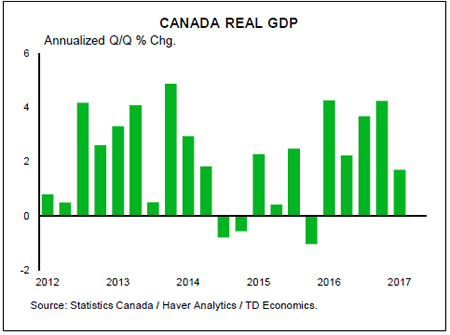U.S. Highlights
- U.S. economic data was relatively constructive this week; existing home sales remained near their multiyear highs, while real GDP expanded by a robust 2.6% (annualized) to cap off last year.
- The IMF upgraded its global economic forecast to 3.9% for this year and next. Managing Director Lagarde hailed it the "broadest synchronised global growth upsurge since 2010."
- This year’s Davos meetings were focused on trade, with Trump, Ross and Mnuchin forming the core of the U.S. delegation. The Treasury Secretary grabbed headlines saying that a "weak dollar is good" for the U.S.
- The ECB and BoJ stood pat on rates, with the Fed likely to follow suit next week at Chair Yellen’s last meeting.
Canadian Highlights
- Canadian retail sales grew again in November, with volumes rising for a second month, pointing to a solid end to 2017 for economic growth.
- A somewhat ho-hum December inflation headline hid ongoing strength in core measures, consistent with the economic strength seen in 2017. The Bank of Canada will likely be happy to see the positive growth-inflation link confirmed.
- Payrolls data for November confirmed the strength of Canadian labour markets. Concerns over the reliability of jobs data appear misplaced, as all three major indicators of jobs growth have been sending the same signal.
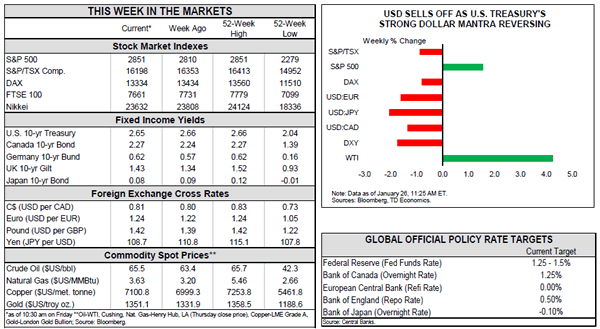
U.S. – Greenback Takes a Beating on Davos Comments
The week got off to a good start, with Congress on Monday voting to end the 69-hour government shutdown. Still, the vote extends funding for the federal government until only February 8th – a mere eighteen days. Markets, having shrugged off the shutdown threat (the new modus operandi in Washington), were neither elated nor surprised about the can being kicked down the road again.
U.S. data was also relatively constructive. Existing home sales remained near multi-year records. Housing markets will have to contend with rising rates and lack of for-sale inventory, but will remain supported by above-trend growth and diminishing slack. U.S. real GDP capped the year with growth of 2.6% (annualized) in Q4 – more than half a point above its potential rate.
Robust U.S. growth comes alongside a solid global backdrop. This week, the IMF updated its global economic forecast to 3.9% for this year and next – 0.2 pp higher than before. The Fund’s Managing Director Lagarde, speaking in Davos, hailed this the "broadest synchronised global growth upsurge since 2010", also highlighting that trade remains a "significant engine of growth."
Trade was a key focus of Davos this year. On the eve of the signing of the new TPP-11, which the U.S. pulled out of, Japanese Economy Minister Motegi said the pact would be an "engine to overcome protectionism," while Canada’s Prime Minister Trudeau called it "the right deal." President Trump, defending his stance, indicated that "America is open for business" and suggested the U.S. may join the TPP if the terms are better.
Still, America’s protectionist policies remain a worry. The U.S. this week levied tariffs on washing machines and solar panels. Defending the move, Commerce Secretary Ross stated that the U.S. approach to trade policy is dated, indicating that he is trying to right past wrongs and that the U.S. is done being "a sucker" or "a patsy" on trade.
But, it was Treasury Secretary Mnuchin that grabbed most headlines, stating that "a weaker dollar is good," – a reversal of U.S. Treasury mantra. A broad U.S. dollar selloff followed, despite attempts by Ross and Trump to repair the damage.
Mnuchin’s comments were criticized by ECB President Draghi who referred to an international agreement last October not to talk down currencies. Speaking after the ECB kept policy rates unchanged this week, Draghi insisted that the bank would consider loosening policy to offset "unwarranted" tightening related to exchange rate. The ECB is unlikely to tighten policy until mid-2019, but is expected to let is bond-buying program lapse in September.
The BoJ also kept rates steady, only altering its inflation outlook wording from "weaker than expected" to "broadly unchanged." And in what will be the last meeting headed by Chair Yellen, the Fed is also likely to stand pat next week. The incoming Chair, Jerome Powel, will take over on February 3rd, having been confirmed by the Senate this week. We don’t expect the policy to be dramatically altered by the change at the top, with our current view for three Fed hikes this year.
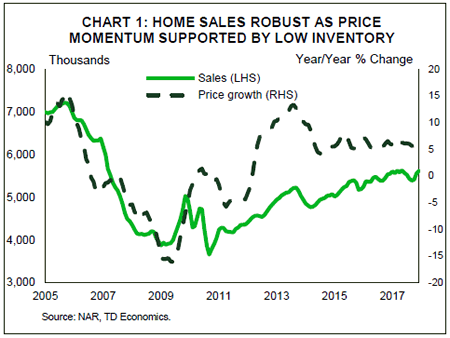
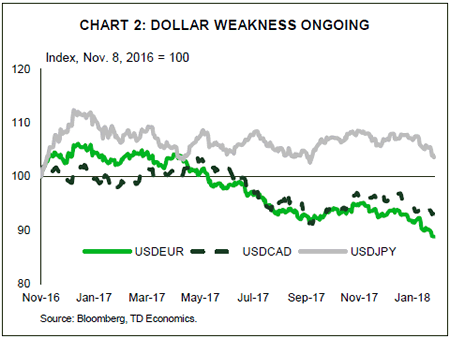
Canada – All Signs Point To A Solid End To 2017
It was a somewhat volatile week in financial markets as attention was focused on the World Economic Forum in Davos, Switzerland. The Canadian dollar rose through the first part of the week, helped by U.S. Secretary of the Treasury Mnuchin’s comments indicating that the U.S. administration was happy with a softer U.S. dollar. President Trump walked this back somewhat, indicating that he favoured a stronger dollar "over time". This sent the U.S. dollar higher, but the effect didn’t last for the loonie, which looks set to end the week around 81 cents U.S., a cent higher than where it began.
Away from market moves, the economic data this week painted a consistent story of the Canadian economy, and a fairly positive one at that. To start with, retail sales rose again in November (Chart 1). While a far cry from October’s robust performance, it was still encouraging, particularly as sales volumes rose for a second month, breaking the string of weakness seen in the third quarter. All signs continue to point to a decent end to 2017, with economic growth tracking in line with the Bank of Canada’s expectations of 2.5% annualized growth in Q4.
The Bank of Canada will also likely be pleased by December’s inflation numbers. Headline inflation, at 1.9% was ho-hum, in line with expectations and helped by still elevated energy prices on a year-ago basis. More importantly, two of the three preferred core measures rose on the month, and the average of these measures now stands at 1.8%, not far off the Bank’s 2% target. This provides some comfort that the relationship between growth and inflation remains intact, and that this month’s rate hike was needed to help control future price growth.
More confirmation of the economy’s strength in the latter half of last year came from the lesser-watched, but still informative Survey of Employment, Payrolls and Hours (SEPH). Released with a lag (November data was just released this week, whereas the more commonly followed Labour Force Survey (LFS) has already been released for December). This survey reported net payroll gains of 16k in November and headline wage gains of 2.8% year-on-year, adding more evidence that 2017 was a year of robust gains for Canadian jobs markets.
To this point, some commentators have dismissed or downplayed recent jobs data, citing volatility in some underlying details of recent LFS reports. The volatility of this data means that monthly reports should be taken with a grain of salt, but it does not mean they should be dismissed. Indeed, when year-to-date jobs growth is considered across the major indicators available, a consistent picture emerges (Chart 2). Both the LFS and SEPH point to strong gains through November, as does the recently introduced, privately-run ADP survey, even with the modest pull-back in job creation reported for December. What’s more, if we remove self-employment from the LFS data (a key difference vs the other reports) to make the series more comparable, we see that this ‘noisier’ series actually paints a slightly softer but still positive story of the Canadian economy, consistent with the other measures. Indeed, if anything the SEPH and ADP figures suggest that LFS has been understating payroll gains. The bottom line is, no matter how you choose to slice it, Canada was a jobs producing machine in 2017.
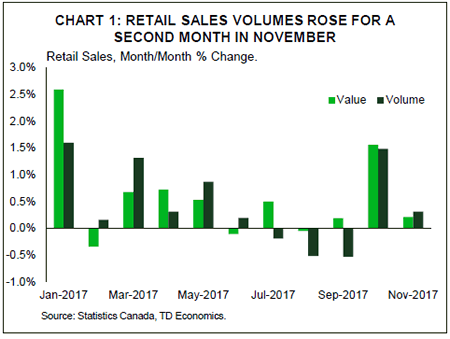
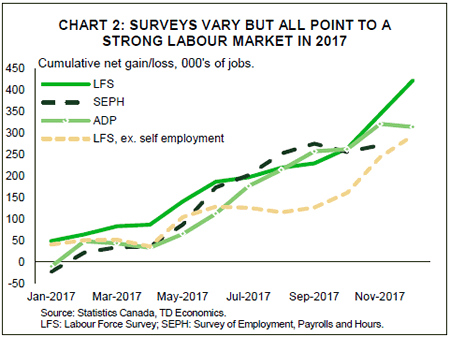
U.S.: Upcoming Key Economic Releases
U.S. Employment – January
Release Date: February 2, 2018
Previous Result: 148k, unemployment rate 4.1%
TD Forecast: 175k, unemployment rate 4.0%
Consensus: N/A
We expect nonfarm payrolls to advance by a respectable 175k in January, below its 3-month average pace as adverse winter weather and some deceleration in employment surveys bias the figure lower in our view. We expect the unemployment rate to slip to 4.0% after holding at 4.1% in the prior three months, as robust job growth and a stabilizing participation rate suggest we are due for a drop. But the focus is more on wages this month, and markets will eye an upside surprise on the back of announcements of wage hikes and bonus increases by firms after the tax reform passage and the scheduled minimum wage hikes in 18 states and 20 cities. The increases on balance point to less than a 0.1pp m/m contribution to January average hourly earnings in our view, similar to the impact in January 2017. Meanwhile, calendar effects introduce a downward bias this month. Taken together, we expect a 0.2% m/m increase, leaving earnings unchanged at 2.5% y/y.
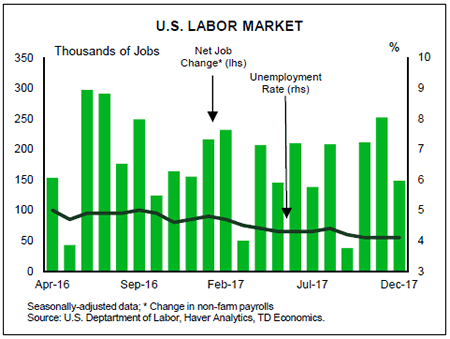
Canada: Upcoming Key Economic Releases
Canadian Real GDP – November
Release Date: January 31, 2018
Previous Result: 0.0% m/m
TD Forecast: 0.3% m/m
Consensus: N/A
TD looks for a 0.3% advance in industry-level GDP for November, with outperformance in the goods-producing industries which have been previously been held back by supply disruptions. Activity data on exports and manufacturing shipments suggests that such effects are fading, pointing to a solid growth contribution from manufacturing. The record jump in housing starts points to strength in construction as well. We expect a solid advance from services on account of upbeat data on consumer spending and home sales. Our forecast is consistent with Q4 real GDP tracking near 2.5%, matching the Bank’s forecast.
